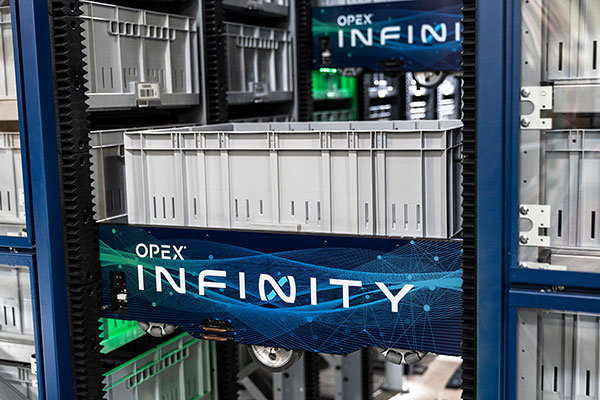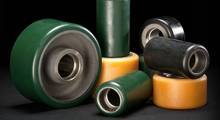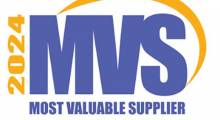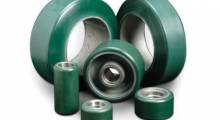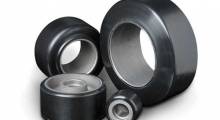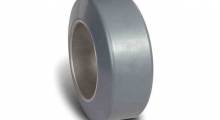Among many intralogistics solutions available, the automated storage and retrieval system (AS/RS) has become a staple. Companies of all sizes and industries rely on AS/RS solutions to enable modern warehousing and fulfillment. OPEX® raised the bar by releasing the Infinity™ system at MODEX 2022. This next-generation goods-to-person (G2P) system offers top-tier storage density, modularity and flexibility. Using wireless Infinity iBOT® robotic vehicles, triple-deep tote storage and OPEX’s proprietary Cortex™ software platform, Infinity delivers the right SKU to the right workstation every time, increasing storage capacity by 35% while making bot paths up to 65% more efficient.
Beckhoff spoke with Monty McVaugh, Manager of Product Management at OPEX, to explore what sets Infinity apart on a technical level. In addition to many impressive in-house technology developments at OPEX, the EtherCAT industrial Ethernet system and other automation technologies play an important role in meeting fulfillment requirements with sustainability in mind.

Monty McVaugh, Manager of Product Management at OPEX®
Why are AS/RS solutions in such high demand today?
Monty McVaugh: There are several aspects to consider. First, ongoing labor shortages and rising labor costs mean companies need to leverage their existing workforce efficiently and safely. This means they are not continually walking the warehouse aisles and climbing ladders to manually pick parts, which leads to burnout. Second, the cost of warehouse real estate is at an all-time high, so companies need to optimize how they use each square foot. Next, inventory security is critical, especially in industries like pharmaceuticals – robotic technologies, including AS/RS solutions, solve these challenges. Finally, with clear value-add benefits from automation, more companies are futureproofing their business by investing in technology before prices increase or they fall behind the competition.
What technology trends are you seeing in the AS/RS market?
MM: One key initiative is optimizing order fulfillment logic and capabilities in addition to control software. The objective is to funnel orders rapidly. Once consumers click “Purchase” on the e-commerce site, the order should be picked and shipped out in under 15 minutes. Many companies are focused on workstation ergonomics. From a fulfillment software perspective, using past order information helps predict orders, buffer and slot inventory to keep products from sitting in the AS/RS. For other companies, shipping orders in under 15 minutes means deploying robotic picking and palletizing solutions. Labor resources shift to quality control or retrain for more skilled tasks.
But scaling these solutions still presents a major challenge, regardless of the company’s size. Many of our customers believe their operations are too small to automate, so they think a positive ROI will take years, particularly for large, complex systems. With increasing labor costs, that ROI equation makes more sense. OPEX prioritized making a modular, scalable and flexible system with Infinity to help make people more comfortable with the investment. We incorporated customer feedback to provide infinite possibilities. That’s where the name comes from — the idea of enabling infinite configurations, settings, options and more.
How is the Infinity system different from other AS/RS offerings?

The Infinity™ system’s iBOT® robotic vehicles can travel in X, Y and Z coordinates – and even leave the storage grid.
MM: In traditional AS/RS solutions, shuttles travel horizontally on a set row, and they bring inventory to an elevator. In contrast, the Infinity iBOTs have access to all inventory in the storage grid because they can travel in X, Y and Z coordinates. And unlike others on the market, our iBOTs can leave the storage grid to bring the inventory to detached workstations. Decoupling these stations from the AS/RS structure offers greater flexibility. For example, the iBOT could bring the tote or case to a pick-and-place robot for palletizing.
Infinity is not your traditional AS/RS. It offers new dimensions of operational freedom that help users adapt to changing consumer demands or business requirements.
What were the biggest technical challenges when creating the iBOTs?
MM: Traffic management and communication to the iBOTs in real time are the two most challenging aspects of our whole system. The ability to plan the shortest path and optimize the traffic route around other iBOTs is a differentiator for OPEX. Our software predicts the moves that bots will make 10 steps ahead and updates routes in real time for peak efficiency.
How important is EtherCAT to achieve this real-time performance?
MM: Many elements of our system, even at the iBOT level, require the real-time communication of EtherCAT. The traffic controller and hundreds of bots exchange packets and messages over Wi-Fi. Also, receiving data from individual system modules — such as our bots or conveyance equipment — helps us manage alerts, events and logs, then send that information to our cloud for analytics.
Using EtherCAT, we can do all of this in milliseconds. That is critical for Infinity’s functionality moving forward. OPEX is a member of the EtherCAT Technology Group (ETG), and we’ve developed our own EtherCAT devices to meet our specific needs. Not having the determinism, flexibility and openness of EtherCAT would shackle our ability to innovate.

Real-time EtherCAT communication, I/O and integrated safety from Beckhoff boost performance throughout the AS/RS.
MM: Without FSoE, our safety architecture would be outdated and expensive. We divide Infinity’s storage grid into “multi-zone safety zones,” and the iBOTs constantly communicate their current location. Using the EK1960 TwinSAFE Compact Controller from Beckhoff, we can shut down individual zones when a safety gate on the perimeter fence is opened. But the unaffected zones can continue running, which ensures high availability.
Networking safety devices together via EtherCAT helps us establish a central command center, streamlines documentation and allows customers to reconfigure or expand systems with ease. The EK1960 further supports this modularity; you can easily add further I/O to the terminal unlike other safety PLCs that require excess hardware and redundancy additions. FSoE is also key to obtaining certifications for international Infinity deployments.
How does the EP7402 EtherCAT Box optimize control of motor-driven roller (MDR) conveyors on the AS/RS?
MM: Our G2P system supports fully automated options to convey cases and totes to the operator. The EP7402 MDR controller delivers a plug-and-play solution to scale our conveyance capabilities. Because of the flexibility of EtherCAT, we can easily add a 6-foot section, for example. Our conveyance controls, the same software that routes the box on Infinity, can route containers on homegrown and third-party conveyors via EtherCAT and the EP7402.
What Beckhoff resources helped in designing and launching the Infinity system?
MM: Regarding technology, having access to and time to learn TwinCAT automation software has been extremely valuable. We can easily configure the safety systems in TwinCAT, then make changes as the application evolves. On the business side, we started developing Infinity during the pandemic, and despite ongoing supply chain challenges, Beckhoff customer service has delivered a positive experience. We greatly value having a direct point of contact at the company, rather than going through a distributor and having information slowly filter down.
How are you continuing to enhance the Infinity system’s performance and reliability?
MM: We leverage invariance and selectivity machine learning algorithms on all the data we send to the cloud. That can include events and logs from the bots, conveyance and other equipment as well as performance indicators at operator stations. Behind the scenes, the system gathers data and generates reports based off those datasets to give us trend analysis. As such, we can study and model system performance, boost reliability, increase mean time to failure and schedule maintenance.
The data might also tell us to flash an update on the control panel at certain intervals, for example, to make operators more alert and increase their performance. By gathering as much data as possible through fast EtherCAT communication, we learn from our machines and subsystems to determine which aspects deserve a closer look.
OPEX: Sustainably driving warehouse automation
OPEX is a leading supplier of solutions for warehouse automation and document and mail automation. The company counts 48 companies in the Fortune 100 as customers. With more than 1,600 employees across five continents, OPEX has continually grown since its founding in 1973 as a mail automation equipment supplier, primarily for Columbia Records. Al Stevens purchased the company in 1975, and now three generations of the Stevens family serve in leadership.
Based in Moorestown, New Jersey, OPEX maintains offices in Plano, Texas, along with Australia, England, Ireland, France, Switzerland and, most recently, Germany. Beyond delivering energy-efficient solutions, the company has a deeper commitment to sustainability, powering its manufacturing facilities with solar, wind and other renewable energy sources.
Article topics
Learn More
